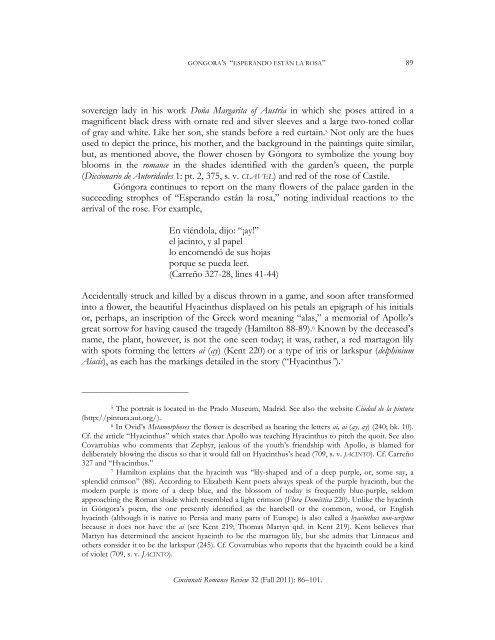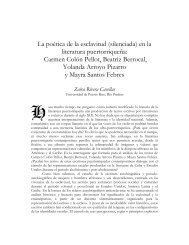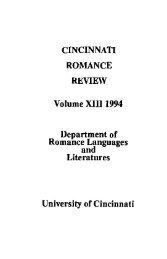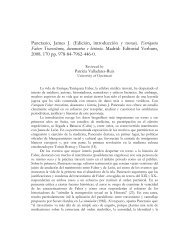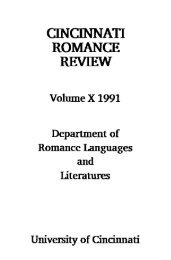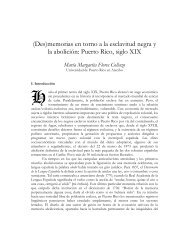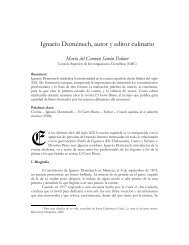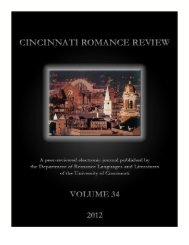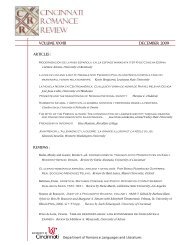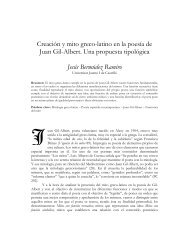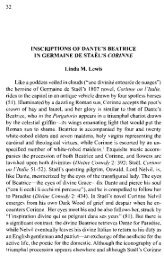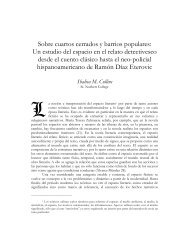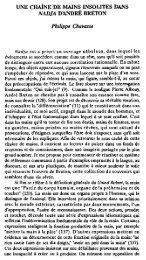88 DIANE CHAFFEE-SORACEWhereas the European honey bee is dark brown and mustard in color, the bumble beeis black and yellow (“Everything about Honey Bee” and “Everything about BumbleBee”). Each type of drone bee is without a stinger (the only aguijón being itsreproductive organ) and has the job of fertilizing the queen (“Everything about HoneyBee”). Unlike the male honey bee, the drone bumble bee forages for and collects thenectar of flowers (“Everything about Bumble Bee”), the sweet spoils referred to byGóngora. By comparing the insect in the poem to Cupid soliciting flowers and thendeserting them, the poet draws a parallel between the drone bumble bee and Lerma. Astold by Salvador Miranda in his “General List of Cardinals (112-2007),” the duke wooedand became betrothed to a rich widow, the countess of Valencia, who the valido laterjilted, cancelling the wedding which was to take place in 1610 and causing theabandoned lady to feel very resentful (cf. Cabrera de Córdoba 418; 421). Moreover, justas the bee steals nectar from the flowers, Lerma is reputed to have pillaged the country,depriving its citizens of their wealth and power as well as taking advantage of the king’sfavor to enrich his relatives, friends, and self (Feros 181). Acting as a drone, he hadaccess to the queen, and he tried hard to control her contact with Austrian sympathizersor with anyone whose political motives were contrary to his own. Appropriately, theescutcheon of the Sandoval family has a field (“surface”) or (“gold”) with a bend (“band”)sable (“black”)—the colors of the bumble bee. 2 The Duke of Lerma’s shield is parted perpale (“vertically”): the dexter (“bearer’s right”) half or has a bend sable (the Sandoval coat ofarms), and blazoned on the sinister (“bearer’s left”) half or are five mullets (“stars”) ofeight azure (“blue”) (the Rojas escutcheon). 3While the bee visits the flowers in Góngora’s poem, the carnation is seen aselegantly displaying the colors of the rose queen for it is her prince. Obviously, thecarnation personifies Spain’s heir to the throne, Philip IV, who, in Juan Pantoja de laCruz’s 1607 picture, The Infantes Don Felipe and Doña Ana, is painted wearing black andsilver clothing and a large whitish gray ruff. Although the artist, in a note sent to theaccountants of Queen Margaret, states that the child’s outfit is that of a monk (Reuter264), the little boy appears regal sitting in a throne-like carretón on a red carpet; there“the discreet curtains folded back on the upper-left corner of the image ‘crown’ thefuture Felipe IV” (Reuter 264). 4 Also, around 1607, Pantoja de la Cruz portrayed the______________________2 For the layman the gold (or) of a shield is represented in art by either yellow paint or gold leaf(Franklyn and Tanner 244, s. v. or). Throughout the article I have italicized the heraldic terminology and,as is generally done, placed the names of tinctures (“furs, colors, or metals”) after the noun.3 The bend sable on the duke’s escutcheon is a thick black band extending diagonally from theupper right corner of the shield’s dexter half to the lower left corner of the same half. See the illustrationof the Sandoval shield in Grixalba (273). See also the description and drawing of the Rojas shield in Elián(234).4 Giménez and Serraller provide a picture of this painting housed in the KunsthistorischesMuseum, Vienna (265).<strong>Cincinnati</strong> <strong>Romance</strong> <strong>Review</strong> <strong>32</strong> (Fall <strong>2011</strong>): 86–101.
GÓNGORA’S “ESPERANDO ESTÁN LA ROSA” 89sovereign lady in his work Doña Margarita of Austria in which she poses attired in amagnificent black dress with ornate red and silver sleeves and a large two-toned collarof gray and white. Like her son, she stands before a red curtain. 5 Not only are the huesused to depict the prince, his mother, and the background in the paintings quite similar,but, as mentioned above, the flower chosen by Góngora to symbolize the young boyblooms in the romance in the shades identified with the garden’s queen, the purple(Diccionario de Autoridades 1: pt. 2, 375, s. v. CLAVEL) and red of the rose of Castile.Góngora continues to report on the many flowers of the palace garden in thesucceeding strophes of “Esperando están la rosa,” noting individual reactions to thearrival of the rose. For example,En viéndola, dijo: “¡ay!”el jacinto, y al papello encomendó de sus hojasporque se pueda leer.(Carreño <strong>32</strong>7-28, lines 41-44)Accidentally struck and killed by a discus thrown in a game, and soon after transformedinto a flower, the beautiful Hyacinthus displayed on his petals an epigraph of his initialsor, perhaps, an inscription of the Greek word meaning “alas,” a memorial of Apollo’sgreat sorrow for having caused the tragedy (Hamilton 88-89). 6 Known by the deceased’sname, the plant, however, is not the one seen today; it was, rather, a red martagon lilywith spots forming the letters ai (ay) (Kent 220) or a type of iris or larkspur (delphiniumAiacis), as each has the markings detailed in the story (“Hyacinthus”). 7______________________5 The portrait is located in the Prado Museum, Madrid. See also the website Ciudad de la pintura(http://pintura.aut.org/).6 In Ovid’s Metamorphoses the flower is described as bearing the letters ai, ai (ay, ay) (240; bk. 10).Cf. the article “Hyacinthus” which states that Apollo was teaching Hyacinthus to pitch the quoit. See alsoCovarrubias who comments that Zephyr, jealous of the youth’s friendship with Apollo, is blamed fordeliberately blowing the discus so that it would fall on Hyacinthus’s head (709, s. v. JACINTO). Cf. Carreño<strong>32</strong>7 and “Hyacinthus.”7 Hamilton explains that the hyacinth was “lily-shaped and of a deep purple, or, some say, asplendid crimson” (88). According to Elizabeth Kent poets always speak of the purple hyacinth, but themodern purple is more of a deep blue, and the blossom of today is frequently blue-purple, seldomapproaching the Roman shade which resembled a light crimson (Flora Doméstica 220). Unlike the hyacinthin Góngora’s poem, the one presently identified as the harebell or the common, wood, or Englishhyacinth (although it is native to Persia and many parts of Europe) is also called a hyacinthus non-scriptusbecause it does not have the ai (see Kent 219; Thomas Martyn qtd. in Kent 219). Kent believes thatMartyn has determined the ancient hyacinth to be the martagon lily, but she admits that Linnaeus andothers consider it to be the larkspur (245). Cf. Covarrubias who reports that the hyacinth could be a kindof violet (709, s. v. JACINTO).<strong>Cincinnati</strong> <strong>Romance</strong> <strong>Review</strong> <strong>32</strong> (Fall <strong>2011</strong>): 86–101.
- Page 1 and 2:
CINCINNATI ROMANCE REVIEWA peer-rev
- Page 4 and 5:
External readersAbraham AcostaDanie
- Page 6 and 7:
!Juan Luis Vives y Erasmo de Rotter
- Page 8 and 9:
!Mayhew, Jonathan. Apocryphal Lorca
- Page 10 and 11:
2 SHALISA M. COLLINS(Álvarez Ménd
- Page 12:
4 SHALISA M. COLLINSinvoluntary exp
- Page 15 and 16:
SOBRE CUARTOS CERRADOS Y BARRIOS PO
- Page 17 and 18:
SOBRE CUARTOS CERRADOS Y BARRIOS PO
- Page 19 and 20:
SOBRE CUARTOS CERRADOS Y BARRIOS PO
- Page 21 and 22:
Tanto de aquí como de allá: NewRe
- Page 24 and 25:
16 CARYN CONNELLYbelief that social
- Page 26 and 27:
18 CARYN CONNELLYPaso through the U
- Page 28 and 29:
20 CARYN CONNELLYpresent something
- Page 30 and 31:
22 CARYN CONNELLYprovincialism. The
- Page 32 and 33:
24 CARYN CONNELLYneatly represent t
- Page 34 and 35:
26 CARYN CONNELLYtreatment of Carli
- Page 36 and 37:
28 CARYN CONNELLYConclusionsOne of
- Page 38 and 39:
30 CARYN CONNELLYGoldbarg, Pablo.
- Page 40 and 41:
32 NICOLÁS FERNÁNDEZ-MEDINAavance
- Page 42 and 43:
34 NICOLÁS FERNÁNDEZ-MEDINAEs cla
- Page 44 and 45:
36 NICOLÁS FERNÁNDEZ-MEDINAde los
- Page 46 and 47: 38 NICOLÁS FERNÁNDEZ-MEDINAasí d
- Page 48 and 49: 40 NICOLÁS FERNÁNDEZ-MEDINAfigura
- Page 50 and 51: 42 NICOLÁS FERNÁNDEZ-MEDINAdel gr
- Page 52 and 53: Gran Señor y rajadiablos: Sátira
- Page 56: 48 LUIS HERMOSILLAfamiliar en el es
- Page 60 and 61: 52 LUIS HERMOSILLAAferrado a los co
- Page 62 and 63: 54 LUIS HERMOSILLAVicuña Urrutia,
- Page 64 and 65: 56 PAOLA MARÍNligüística, el cua
- Page 66 and 67: 58 PAOLA MARÍNy referencias en su
- Page 68 and 69: 60 PAOLA MARÍNLa renovación que l
- Page 70 and 71: 62 PAOLA MARÍNclave en Borges, sin
- Page 72 and 73: 64 PAOLA MARÍNdel bachiller Franci
- Page 74 and 75: 66 PAOLA MARÍNdebe sobresalir. En
- Page 76 and 77: 68 PAOLA MARÍN---. “Francisco de
- Page 78 and 79: Juan Luis Vives y Erasmo de Rotterd
- Page 80 and 81: 72 OLGA RIVERAingenios y escritores
- Page 82 and 83: 74 OLGA RIVERAque reproducen en min
- Page 84 and 85: 76 OLGA RIVERAentre otros argumento
- Page 86 and 87: 78 OLGA RIVERAreaches age seven) lo
- Page 88 and 89: 80 OLGA RIVERAand hard work” (Ree
- Page 90 and 91: 82 OLGA RIVERAoccupation for the ju
- Page 92 and 93: 84 OLGA RIVERAámbito de la domesti
- Page 94 and 95: Góngora’s “Esperando están la
- Page 98 and 99: 90 DIANE CHAFFEE-SORACEIn Góngora
- Page 100 and 101: 92 DIANE CHAFFEE-SORACEHowever, whe
- Page 102 and 103: 94 DIANE CHAFFEE-SORACEThe bard’s
- Page 104 and 105: 96 DIANE CHAFFEE-SORACEthe fifteent
- Page 106 and 107: 98 DIANE CHAFFEE-SORACE1563 to 1700
- Page 108 and 109: 100 DIANE CHAFFEE-SORACEGilmer, Mau
- Page 110 and 111: Maternal Agency in Lucía Etxebarri
- Page 112 and 113: 104 MARINA BETTAGLIOprocreation no
- Page 114 and 115: 106 MARINA BETTAGLIOwho rescued her
- Page 116 and 117: 108 MARINA BETTAGLIOmystical interv
- Page 118 and 119: 110 MARINA BETTAGLIOnot represent t
- Page 120 and 121: 112 MARINA BETTAGLIOproductions. Li
- Page 122 and 123: 114 MARINA BETTAGLIO“Sé que est
- Page 124 and 125: 116 MARINA BETTAGLIOtheir real-life
- Page 126 and 127: 118 MARINA BETTAGLIO---. “Acerca
- Page 128 and 129: Tu mettrais l’univers entier dans
- Page 130 and 131: 122 JEAN-FRANÇOIS DUCLOS(Battues 4
- Page 132 and 133: 124 JEAN-FRANÇOIS DUCLOSpaupière,
- Page 134 and 135: 126 JEAN-FRANÇOIS DUCLOSmaintient.
- Page 136 and 137: 128 JEAN-FRANÇOIS DUCLOSne peut qu
- Page 138 and 139: 130 JEAN-FRANÇOIS DUCLOSEt pour ce
- Page 140 and 141: 132 JEAN-FRANÇOIS DUCLOSŒUVRES CI
- Page 142 and 143: 134 REGINA L. PESZATsimplicity, Ern
- Page 144 and 145: 136 REGINA L. PESZATbourgeoises de
- Page 146 and 147:
138 REGINA L. PESZATTransfiguration
- Page 148 and 149:
140 REGINA L. PESZATthe impoverishe
- Page 150 and 151:
142 REGINA L. PESZATillusion simila
- Page 152 and 153:
144 REGINA L. PESZATOne might hypot
- Page 154 and 155:
Entre deux régimes de censure:Le c
- Page 156 and 157:
148 EDWARD OUSSELINEn France, “l
- Page 158 and 159:
150 EDWARD OUSSELINquelque sorte, p
- Page 160 and 161:
152 EDWARD OUSSELINsocialement bann
- Page 162 and 163:
154 EDWARD OUSSELINEmmanuelle (Just
- Page 164 and 165:
156 EDWARD OUSSELINUn reflet peu no
- Page 166 and 167:
158 EDWARD OUSSELINHeise, William,
- Page 168 and 169:
When Feasting with the Statue Is Du
- Page 170 and 171:
162 KATHRYN WILLIS WOLFEAu tournant
- Page 172 and 173:
164 KATHRYN WILLIS WOLFEproblematic
- Page 174 and 175:
166 KATHRYN WILLIS WOLFEformed part
- Page 176 and 177:
168 KATHRYN WILLIS WOLFEto imitate,
- Page 178 and 179:
170 KATHRYN WILLIS WOLFEthe word ca
- Page 180 and 181:
172 KATHRYN WILLIS WOLFEemerging se
- Page 182 and 183:
174 KATHRYN WILLIS WOLFEpromises, w
- Page 184 and 185:
176 REVIEWED BY PATRICIA VALLADARES
- Page 186 and 187:
Alberca, Manuel. El pacto ambiguo:
- Page 188 and 189:
180 REVIEWED BY ANDRÉS PÉREZ-SIMO
- Page 190 and 191:
Álvarez, Enrique. DENTRO/FUERA: El
- Page 192 and 193:
184 REVIEWED BY BEATRIZ CELAYA CARR
- Page 194 and 195:
ROMANCERO 179Hispanista ya había p
- Page 196 and 197:
ROMANCERO 181Aunque no ha encontrad
- Page 198 and 199:
Fisher, Andrés. Series. Poesía re
- Page 200 and 201:
192 REVIEWED BY MARÍA CLEMENCIA S
- Page 202 and 203:
194 REVIEWED BY MANUEL CERPAAunque
- Page 204 and 205:
196 REVIEWED BY MANUEL CERPAtanto d
- Page 206 and 207:
198 REVIEWED BY PEDRO P. PORBÉNent
- Page 208 and 209:
200 REVIEWED BY PEDRO P. PORBÉNEn


